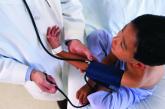From the Journals

AAP releases revised guidelines on screening, treatment of hypertension
Start measuring blood pressure annually at age 3 years.

FROM PEDIATRICS
New clinical guidelines for pediatric hypertension resulted in increased prevalence of hypertension and improved sensitivity in detecting target organ damage among at-risk youth, according to findings published in Pediatrics.
In a clinical practice guideline (CPG) published in 2017, the American Academy of Pediatrics updated its 2004 guideline to include new reference tables for BP values in addition to new definitions of elevated BP and hypertension, including absolute BP cutoff values for adolescents aged 13 years and older (Pediatrics. 2017 Sep;140[6]:e20173035). This was intended to “emulate the recently updated adult hypertension guidelines and to simplify the process of identifying and classifying hypertension in adolescents,” wrote Michael Khoury, MD, of the Heart Institute at Cincinnati Children’s Hospital Medical Center, and his coauthors.
To evaluate the impact of the new guidelines on the prevalence of hypertension and associations with target organ damage, the investigators used data from a study on obesity and type 2 diabetes in 364 patients aged 10-17 years; 59% were obese, and 30% had type 2 diabetes. Three groups were identified: patients with obesity and type 2 diabetes, patients with obesity but no type 2 diabetes, and healthy (“lean”) controls.
Patients fasted overnight for a minimum of 10 hours, after which body mass index was calculated, blood pressure was taken, and anthropometric, laboratory, echocardiography, and carotid assessments were performed. Average BP measurements were categorized according to the 2004 guideline and to the new CPG.
In carotid ultrasonography assessments, a composite of carotid intima-media thickness was formed from the average of three sites, and a composite carotid intima-media thickness greater than or equal to the 90th percentile of that measured in the lean patients, who were the controls, was considered abnormal. In echocardiography assessments, left ventricular mass (LVM) and LVM index were calculated. Elevated LVM was defined by the pediatric cutoff of LVM index greater than or equal to 38.6 g/m.
For diastolic function, tissue Doppler velocities under the 10th percentile and an average early left ventricular filling/peak early myocardial velocity ratio greater than or equal to the 90th percentile in controls were considered abnormal. Lastly, pulse wave velocity (PWV) was measured to determine arterial stiffness, and a PWV greater than or equal to the 90th percentile for the controls was considered abnormal.
BP classification under the new guideline resulted in an increased prevalence of hypertension at 13% (10% stage 1, 3% stage 2), compared with the 2004 guideline at 8% (6% stage 1, 2% stage 2), with a P value of .007.
Of the 75 patients classified as having elevated BP in the 2004 guideline, 19 (25%) were reclassified as having stage 1 hypertension under the CPG. These 19 patients were older, compared with patients who remained in the elevated blood pressure category (16.5 ± 0.9 vs. 15.5 ± 1.7 years; P = .02). The patients who were reclassified also had higher body mass indexes (38.8 ± 8.2 vs. 33.6 ± 7.4; P = .01) and diastolic blood pressures (76.5 mm Hg ± 8.7 vs. 62.1 ± 12.2 mm Hg; P less than .001), Dr. Khoury and his colleagues reported.
Reclassification to a higher BP category was associated with increased odds of an abnormal target organ damage (TOD) values, and both guidelines produced similar odds, “suggesting that the two guidelines produce similar associations with TOD,” the authors wrote. Reclassification based on the CPG definition accounted for 31% of patients with increased LVM, compared with 20% as defined in the 2004 guideline (P less than .001), and for 33% of patients with abnormal PWV, compared with 23% in the 2004 guideline, suggesting improved sensitivity of hypertension categorization in detecting LVM. A similar effect was seen in other measures of TOD, the authors noted.
The findings suggest that, combined with the increased prevalence of hypertension under the new guidelines, “the CPG may contribute to an increased detection of abnormal LVM and other measures of TOD,” the authors wrote. “This, in turn, may contribute to risk stratification in clinical decision making for youth presenting with BP concerns,” they concluded.
The study was supported by a National Institutes of Health grant. The authors had no relevant disclosures.
SOURCE: Khoury M et al. Pediatrics. 2018 Jul 5. doi: 10.1542/peds.2018-0245.

Start measuring blood pressure annually at age 3 years.

SAN FRANCISCO – Some of the advice is similar to the group’s last effort in 2004, but there are a few key changes.
